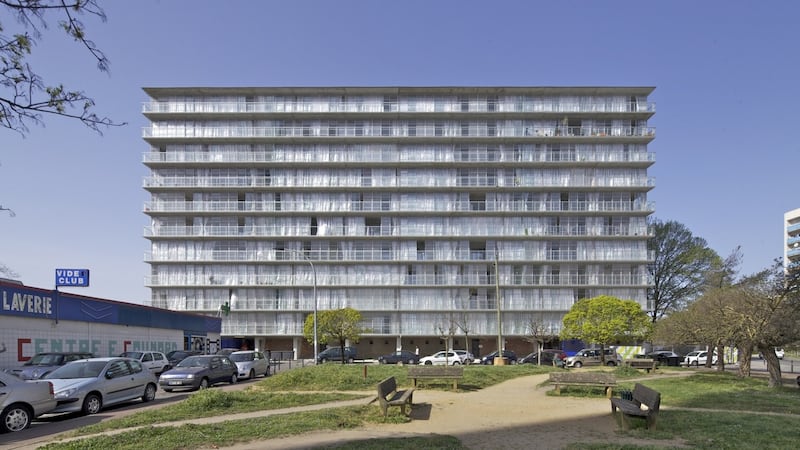Grafton’s Yvonne Farrell and Shelley McNamara have one thing in common with Anne Lacaton and Jean-Philippe Vassal: they won architecture’s premier award, the Pritzker Prize, in 2020 while the French pair got the gong this year.
But their architectural approaches couldn’t be more different, with Grafton using tonnes of concrete in its new-builds while Lacaton & Vassal seeks to minimise the use of carbon-intensive resources by working with existing buildings.
In its citation the Pritzker Prize jury said Lacaton and Vassal had “not only defined an architectural approach that renews the legacy of modernism, but they have also proposed an adjusted definition of the very profession of architecture. The modernist hopes and dreams to improve the lives of many are reinvigorated through their work that responds to the climatic and ecological emergencies of our time, as well as social urgencies, particularly in the realm of urban housing.”
As Anne Lacaton has said, “demolition is probably the worst thing you can do in terms of sustainability”. So when it came to deciding what to do with slab blocks of 1960s social housing at Le Grand Parc in Bordeaux, Lacaton & Vassal persuaded the city authorities not to proceed with earlier plans to demolish these 11-storey buildings. Instead it proposed a radical alternative: to transform living conditions in each block by adding a stack of south-facing winter gardens.
Residents of the 530 apartments involved didn’t even have to move out while the work was under way, and it also ended up costing only about a third of what it would have cost to demolish and replace the three slab blocks.
The objective was to “bring in the light and the sky” so that the flats were no longer “inert boxes” cut off from the outside world, but had 40 per cent more space in the new winter gardens with panoramic views over the historic rooftops of Bordeaux.
Transformation
Along with fellow French architects Frédéric Druot and Christophe Hutin, who also worked on the project, Lacaton & Vassal deservedly won the EU’s Mies van der Rohe Award for Contemporary Architecture in 2019 for Le Grand Parc. I had the privilege of serving as the only non-architect member of the jury that selected it as the overall winner, having visited the completed project and talked to residents who were simply delighted by the transformation of their homes.
As the jury said in its report, “more and more people see, feel and experience that architecture is not anymore about self-referentiality, about doing the best, the most chic and shiny (new buildings)”. Rather, what the climate emergency demands is to do more with less: more architecture with less material and lower costs – just €62,000 per flat in the Bordeaux case. And given that so much carbon is embedded in concrete, manufacturing more of it represents an ecological burden.

“Good architecture is open – open to life, open to enhance the freedom of anyone, where anyone can do what they need to do,” according to Anne Lacaton. “It should not be demonstrative or imposing, but it must be something familiar, useful and beautiful, with the ability to quietly support the life that will take place within it.”
The practice’s philosophy – summed up by a simple slogan “never demolish, always transform” – is now very much in tune with the times we live in.
Lacaton & Vassal first made headlines for its renovation of the 1937 Palais de Tokyo at Trocadéro in Paris. It had already been gutted, exposing its rough concrete frame, by the time it was commissioned in 1999, and it decided to leave it in that raw state while creating a dramatic new venue for contemporary art exhibitions, with a very limited budget of €3 million that almost dictated a minimal intervention approach. “The architecture was already there,” as they explained.
Highly original
By contrast, Grafton Architects has been dubbed as “concrete connoisseurs” for producing mega-structures such as Bocconi University in Milan, UTEC in Lima, the new Marshall Building for London School of Economics off Lincoln’s Inn Fields and Kingston University’s colonnaded Town House student centre, also in London, which recently won the Stirling Prize of the Royal Institute of British Architects (RIBA); it was hailed by Norman Foster as a “highly original work of architecture”.
The Architects’ Journal (AJ), which is running a “retro-first” campaign to promote more renovation of existing buildings, tackled Grafton director Gerard Carty about the use of so much concrete in its buildings. He agreed that “the whole issue of embodied carbon in relation to climate change is something that we all have to take seriously”, and said it had used pre-cast concrete in the Kingston building, with longer spans to ensure that the structure would be “as lean as possible”.
But Carty maintained that “it’s still feasible to use a certain amount of concrete” – deriving cement from ground granulated blast-furnace slag, for example.
“What’s going to happen is that technology will move on,” he said. “There’ll be replacements for cement, and there will be replacements for the more difficult and challenging ingredients in concrete. And rather than turning our backs on it completely maybe we need to also invest in what we can do to make it carbon neutral as a material.”
Commenting on plans by Wilkinson Eyre to replace a 1950s block in London’s Holborn with a “biophilic office scheme”, the AJ’s Will Hurst tweeted: “Another day, another ‘sustainable’ design by a famous architect that starts with demolition… Yet architects remain silent. They won’t criticise their own & the planet will be burnt to a crisp before they do. RIBA code of professional conduct based on ‘honesty, integrity and competence, as well as concern for others and for the environment’. Blah, blah, blah”.
* The Irish Architecture Foundation’s New Now Next: Lacaton & Vassal, moderated by Yvonne Farrell and Shelley McNamara, is on Thursday, November 25th, at 6pm. Register with architecturefoundation.ie











